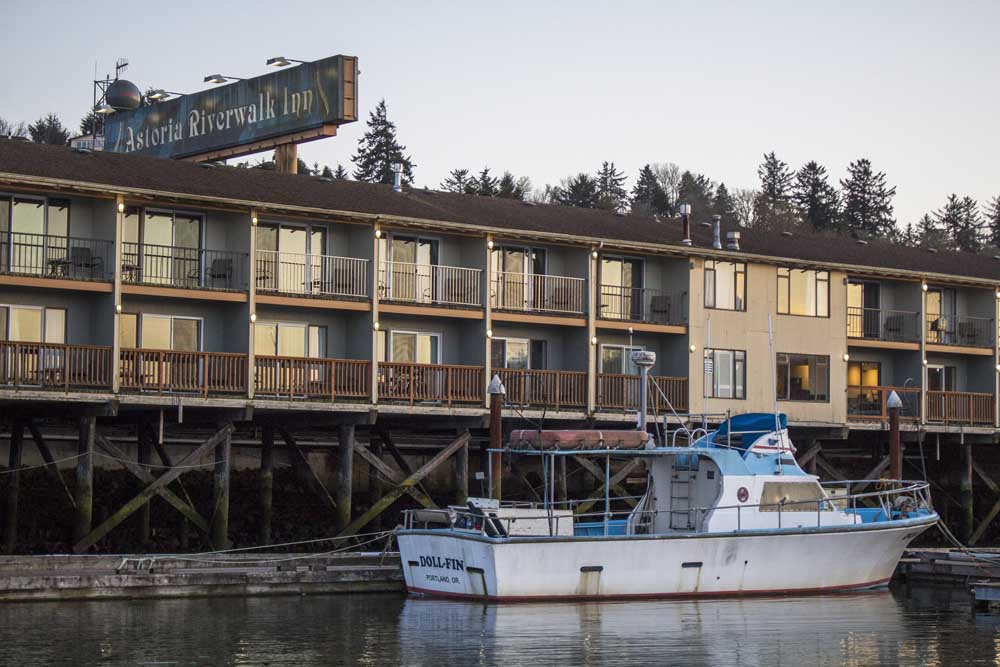Astoria Riverwalk Inn wants clarity before fixing structure
Published 10:51 am Friday, March 19, 2021

- The waterfront master plan includes a new hotel to replace the Astoria Riverwalk Inn.
Ganesh Sonpatki, who runs a network of properties in the Portland area through Param Hotel Corp, tried for years to lease the Astoria Riverwalk Inn from the Port of Astoria. He was spurned repeatedly before suing the Port and forcing a seven-year lease in 2018.
Trending
With less than five years left on his lease and structural issues piling up, Sonpatki wants to know his and the hotel’s long-term future before deciding how much to invest.
The Riverwalk Inn, opened as the Thunderbird Inn in the 1960s, wraps around the West Mooring Basin. Rooms and decks jut out over the basin, offering a bird’s-eye view of the boats below. But the picturesque location along the water also means greater maintenance costs and battering by wind and rain.
Lenny Cheyney has managed the hotel through the past several operators. He recently described to the Port Commission a raft of dry rot, roof and other structural issues facing the hotel.
Trending
“This last January, when we had that huge storm with the landslides that happened on … Highway 30, we had well over 20 leaks throughout the entire property,” Cheyney said.
Since lodging restrictions tied to the coronavirus pandemic were lifted, the hotel is selling out the 90 or so rooms it offers, Cheyney said. But one room was closed after part of the ceiling fell from leaking water with guests inside, he said, while he restricts even his staff from entering another where rot has caused a hole in the floor.
Cheyney showed the commission numerous photos where support beams and walkways are failing because of rot.
The structural issues come as Param has been spending to improve the experience at the hotel, including refurbished rooms and new furniture. Cheyney said Param plans to further improve amenities, including an expanded gym and a lounge in the hotel’s breakfast area overlooking the water.
Commissioners appeared supportive of helping Sonpatki, but voiced concern that some parts of the hotel represent immediate safety concerns and could need to be closed. Sonpatki said the hotel would not rent dangerous rooms to guests and is working with a local architect to assess the level of damage throughout the property.
But Sonpatki tied the feasibility of longer-term structural improvements to the length of his lease and the future of the hotel, which the Port has contemplated selling.
“Where do you see this building?” the hotelier asked the Port Commission. “How does it go in your plans for the future?
“I know there’s a lot of talk about redevelopment,” he said. “How likely is that, and are we looking for a five-year or 10-year, 20-year plan? I know there was also talk about the building being sold. But the way the condition is, by the time somebody walks in there, they’d have to do all this work anyways to make it better.”
Commissioner Robert Stevens said the Port would like to see the Riverwalk Inn become the crown jewel of Sonpatki’s holdings. But some of the issues with the hotel seem immediately unsafe to the public and recall past instances when Port properties were restricted or closed, he said.
“That should strike some fear into us,” Stevens said.
Hanging over any possible investment in the building is whether the Port will sell the hotel and lease the land. The hotel was valued at more than $5 million in a previous appraisal. An analysis showed the agency could make up to $4 million more over the next decade by selling the building and leasing the land.
Will Isom, the Port’s executive director, said many of the questions about the future of the hotel could be answered by the master plan Astoria agreed to pay for using urban renewal money. The plan is expected to be ready in the fall.
“I do think, at least from my perspective, it likely makes more sense for the Port to sell the facility and just maintain a land lease,” he said. “… This maintenance-repair issue would be a lot simpler if the building was actually owned by a private entity, and therefore they have a built-in business incentive to make sure that repairs and upkeep are done on the building.”









